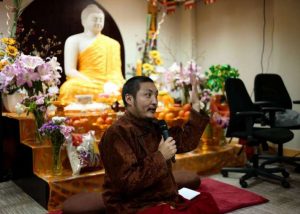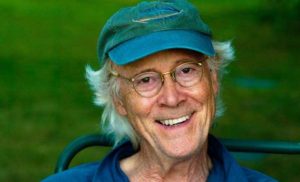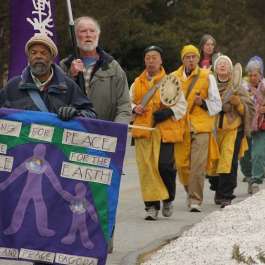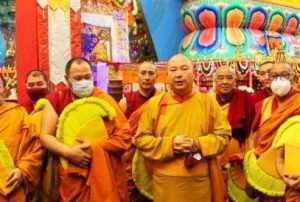
Master Dejian is the 18th generation master of the Yonghuatang* of Shaolin Temple, a successor of what is known as Shaolin Chanwuyi, and the abbot of Songshan Monastery. He has been studying and practicing Shaolin Chanwuyi on Shaoshi Mountain for more than 20 years. In that time, he has become proficient in Chan healing and has helped many who were sick. He is also a successor of the heritage of Shaolin Xinyiba, the highest level of Chanquan.**
Songshan Monastery is situated on the peak of Shaoshi Mountain in China’s Henan Province. It is here, 1,512 meters above sea level, that Master Dejian practices martial arts at the edge of a sheer precipice. Despite the danger of falling to his death from just one second of inattentiveness, Master Dejian continues to practice every day. And while such exercises would fill many with fear and anxiety, his emotions remain steady as a rock. In a recent interview with Buddhistdoor, Master Dejian observed that the reason he practices Wushu on the edge of the cliff is, in fact, to overcome this fear of death; to face the fear and eventually let the feelings dissipate. It is the same way that Chan masters approach their everyday problems: face them, accept them, deal with them, and finally let them go.

Face your fears to let them go
To honor the commitment made to his mentor Master Suxi, the former abbot of Shaolin Temple, Master Dejian undertook the renovation of Songshan Monastery from 1994. Because of its location on the peak of Shaoshi Mountain, there is only one path leading there made up of more than 1,000 steps. “Therefore,” he told us, “building materials such as cement and tiles must be transported on foot from the foot of the mountain to the peak.” This makes renovation work a very challenging undertaking.
Although far from easy, Master Dejian was able to overcome these obstacles. For example, he first addressed the safety issues for workers transporting the building materials. He explained: “My disciples and I needed to travel to and fro several times a day, bearing hundreds of kilograms of materials, so I had to find a way that we could balance ourselves to avoid accidents.” Master Dejian’s practice at the edge of the precipice is a testament to his expertise in this area.

Another reason that Master Dejian chooses to practice his martial arts in such a precarious position is to train the balance of his heart. “I don’t practice on the edge of the cliff for adventure, but to train and achieve a balanced state of mind,” he explained, laughing. “I was afraid of death. However, if I want to overcome this fear, I have to face it. Therefore I go to the cliff as a way of confronting death.”
“At first I was very frightened when I was on the cliff, but the more fearful I am, the more careful I need to be,” he said. “I have to disregard all distractions and keep my mind solemn and quiet. Thus, my fear can be overcome.” Now when Master Dejian faces the cliff, his emotions are steady as a rock, yet his disciples still worry about his death-defying feats. “Each time I practice on the cliff edge, they worry about me and hope that I will come down quickly. Yet I take the opportunity to remind them that reincarnation is bitter. I hope that they can understand: if they do not want to die with regrets, they have to stand firm and keep learning.”
Master Dejian has enlightened his disciples through experiencing and demonstrating techniques and practices to balance body and mind. To the master himself, it represents the attitude of a Chan practitioner: to face the fear of death and overcome it—an attitude rooted in Chanwuyi.
Shaolin Chanwuyi
Shaolin Chanwuyi is a unique branch of Chan Buddhism with a long history. “Its development can be traced back to China’s Ming dynasty [1368–1644],” Master Dejian observed. He describes Chanwuyi as “a branch of Buddhism that can help one achieve happiness in the face of suffering. However, in the eyes of society, Chanwuyi is often viewed merely as a means to maintain physical health.”
Master Dejian explained a classic example if this misunderstanding that he encountered many years ago. A famous university in the United States wanted to set up a Chanwuyi center, and a representative from the university visited Master Dejian at Songshan Monastery to invite him to join the center, saying: “We have found professionals and doctors in Chan already, however, we lack an expert who understands Shaolin marital arts.” The visiting professor wanted to invite Master Dejian to the center, so that could have experts from all three disciplines: Chan, Wu, and Yi.
Shaking his head with a smile, Master Dejian related: “Some people misunderstand Chanwuyi as a simple combination of Chan, Wu, and Yi. To them, Chan means to sit in a particular place, Wu means Wushu, Yi means to heal.” But, Master Dejian pointed out, Chanwuyi blends Chan, Wu, and Yi based on Buddhist teachings, including the Diamond Sutra, the Lankavatara Sutra, and the Platform Sutra.
He further explained: “Through practicing marital arts and Shaolin Nei Yong Gong,*** practitioners can understand the meridians in the body, and the condition of both body and mind, thus healing their own body and mind effectively. The Yi in Chanwuyi refers to the healing of the mind. When our mind is sick, we are full of the three unwholesome roots—greed, anger, and obsession. These damage our mind-body condition and harmony within the family.” Therefore, Chan, Wu, and Yi are each indispensable and of equal importance.

Why do we have to practice Chan?
Shaolin Temple is the birthplace of Chinese Buddhism and as a branch of Buddhism, Chan plays a pivotal role in Chanwuyi. But what is Chan? Master Dejian emphasized that Chan is not merely sitting blankly, but is in fact a state of mind. He used the Platform Sutra to explain: “To sit means to be separated from external matters. To meditate means to not be confused inwardly. If we can concentrate and clear our mind of evil thoughts, our mind will be peaceful.”
Chanwuyi is a way to achieve release from suffering in daily life. To practice Chanwuyi, one must also monitor one’s diet. According to Master Dejian, Chanwuyi practitioners may not eat meat, garlic, ginger, or other “heating” foods: “We become sick because of improper dietary habits, such as consuming meat and foods that generate too much heat within the body. We should therefore stop eating them. Even though some of these foods add flavor, the health of patients will worsen and their mood will become irritated after eating them.” If we do not change our diets, it is difficult to practice Chan and Wu, let alone achieve the state of Chan.

Master Dejian continued: “We must practice Chan in our daily lives in order to learn how to realize ourselves. So many people have tight schedules, leading to lives full of fears, pains, and worries. As a result, people develop various diseases and conditions. This seems to be a problem for society, but in fact it is a problem of the human mind. When we have problems in our minds, we must heal ourselves by practicing Chan. If everyone practiced Chan and acted with compassion toward others, then society would be much improved. Conversely, if we become sick and do not practice Chan, it does not matter how much medicine we take.”
* According to Shaolin history, the temple is divided into 18 schools, one of which is Yonghuatang.
** Xinyiba is the highest level of traditional Shaolin gongfu, known as Chanquan.
*** A traditional Chinese Shaolin healing practice based on mind-body intervention.
See more













